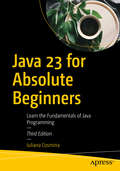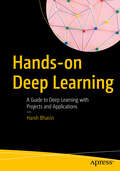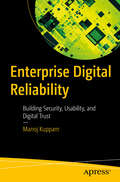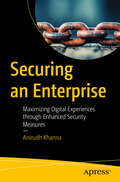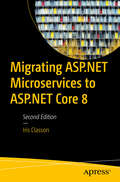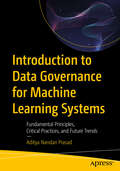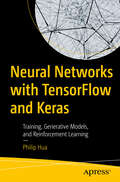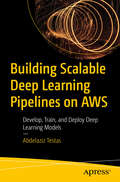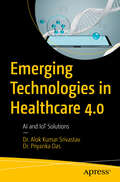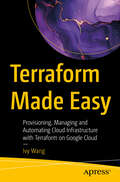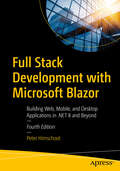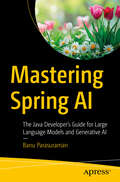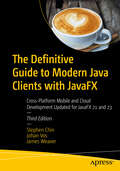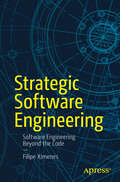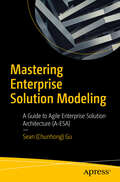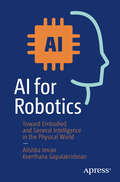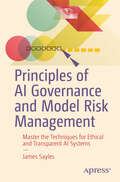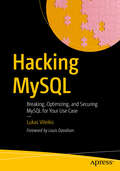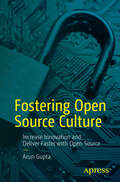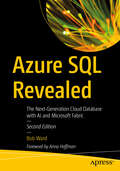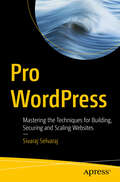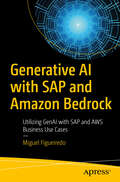- Table View
- List View
Java 23 for Absolute Beginners: Learn the Fundamentals of Java Programming
by Iuliana CosminaWrite your first code in Java 23 using simple, step-by-step examples that model real-word objects and events, making learning easy. With this book you will be able to pick up core programming concepts without fuss and write efficient Java code in no time. Clear code descriptions and layout ensure you get your code running as soon as possible. Author Iuliana Cosmina focuses on practical knowledge and getting you up to speed quickly—all the bits and pieces a novice needs to get started programming in Java. In this edition, you will discover how Java has changed since version 17, and how to design and write code using the most recently introduced Java features such as new collection methods, virtual threads, pattern and record matching in switch expressions, structured concurrency tasks, unnamed classes and instance methods, and many more. This book is a complete Java guide, covering the following topics: setting up a development environment, programming concepts and well-known programming principles, writing Java code following industry-specific design patterns and coding conventions, executing it, debugging, testing, documenting it and even using specialized tools such as IntelliJ IDEA for writing Java code, Maven for building, JUnit Jupiter for testing, and in-memory and Docker-hosted databases or data storage. After reading this book, you’ll have all the necessary skills and knowledge to pass an interview for a starting Java development position. What You Will Learn Set up a Java development environment Use the Java language to write high-quality code Understand fundamental programming concepts and algorithms Use virtual threads, records, and other Java renown features Debug, test, and document Java code Improve performance by customizing the Garbage Collector Who This Book Is For Those who are new to programming and want to learn Java and use it to build efficient solutions
Pro Oracle Database 23ai Administration: Manage and Safeguard Your Organization’s Data
by Darl Kuhn Michelle MalcherMaster Oracle Database administration in both on-premises and cloud environments. This new edition covers the tasks you’ll need to perform to keep your databases tuned and performing, and includes new, important innovations with AI Vector Search, JSON Duality Views, and Select AI. Since Oracle Database 23ai offers a choice of platforms with on-premises and cloud, the book also includes administrative tasks specific to cloud environments, including the Oracle Autonomous Database running in the Oracle Cloud Infrastructure. New in this edition is help for DBAs who are becoming involved in data management, and a look at the idea of a converged database and what that means in handling various data types and workloads. The book covers some of the machine learning features now in Oracle and shows how the same SQL that you know for database administration also helps you with data management tasks. The information in this book helps you to apply the right solution at the right time, mitigating risk and making robust choices that protect your data and avoid midnight phone calls. Data management is increasingly a DBA function, and DBAs are often called upon for help in getting data loaded into analytics environments such as a data lakehouse or a data mesh. This book addresses this fast-growing new role for database administrators and helps you build on your existing knowledge to make the transition into a new skill set that is in high demand. You’ll learn how to look at data optimization from the standpoint of data analysis and machine learning so that you can be seen as a key player in preparing your organization’s data for those type of activities. You’ll know how to pull back information from a combination of relational tables and JSON structures. You’ll become familiar with the tools that Oracle Database provides to make analytics easier and more straightforward. And you’ll learn simpler ways to manage time-based tables that eliminate the need for painfully creating triggers to track the history of row changes over time. This book builds your skills as an Oracle Database administrator with the aim of helping you to be seen as a key player in data management as your organization pivots toward cloud computing and a greater use of machine learning and analytics technologies. What You Will Learn Configure and manage Oracle 23ai databases both on-premises and in the cloud Meet your DBA responsibilities in the Oracle Cloud and with Database Cloud Services Leverage converged database capabilities to manage different workloads, structured and unstructured data Perform administrative tasks for Autonomous Database dedicated environments Perform DBA tasks and effectively use data management tools Migrate from on-premises to the Oracle Cloud Infrastructure Troubleshoot issues with Oracle 23ai databases and quickly solve performance problems Architect cloud, on-premises, hybrid, and multi-cloud database environments Who This Book Is For Oracle database administrators (DBAs) who want to be current with the new features in Oracle Database 23ai. For any DBA who is tasked with managing Oracle databases in cloud, hybrid cloud, and multi-cloud configurations. Also helpful for data architects who are designing analytic solutions in data lake house and data mesh environments.
Hands-on Deep Learning: A Guide to Deep Learning with Projects and Applications
by Harsh BhasinThis book discusses deep learning, from its fundamental principles to its practical applications, with hands-on exercises and coding. It focuses on deep learning techniques and shows how to apply them across a wide range of practical scenarios. The book begins with an introduction to the core concepts of deep learning. It delves into topics such as transfer learning, multi-task learning, and end-to-end learning, providing insights into various deep learning models and their real-world applications. Next, it covers neural networks, progressing from single-layer perceptrons to multi-layer perceptrons, and solving the complexities of backpropagation and gradient descent. It explains optimizing model performance through effective techniques, addressing key considerations such as hyperparameters, bias, variance, and data division. It also covers convolutional neural networks (CNNs) through two comprehensive chapters, covering the architecture, components, and significance of kernels implementing well-known CNN models such as AlexNet and LeNet. It concludes with exploring autoencoders and generative models such as Hopfield Networks and Boltzmann Machines, applying these techniques to a diverse set of practical applications. These applications include image classification, object detection, sentiment analysis, COVID-19 detection, and ChatGPT. By the end of this book, you will have gained a thorough understanding of deep learning, from its fundamental principles to its innovative applications, enabling you to apply this knowledge to solve a wide range of real-world problems. What You Will Learn What are deep neural networks? What is transfer learning, multi-task learning, and end-to-end learning? What are hyperparameters, bias, variance, and data division? What are CNN and RNN? Who This Book Is For Machine learning engineers, data scientists, AI practitioners, software developers, and engineers interested in deep learning
Enterprise Digital Reliability: Building Security, Usability, and Digital Trust
by Manoj KuppamGain a comprehensive understanding of digital reliability to ensure consistent, dependable user experiences that foster trust in technology. Part of author Saurav Bhattacharya’s trilogy that covers the essential pillars of digital ecosystems—security, reliability, and usability—this book tackles the challenges of achieving high reliability in complex systems and provides strategies to overcome these obstacles. You’ll start by reviewing the pivotal role of reliability in establishing the foundation of digital trust, essential for the sustainable growth of digital ecosystems. In today's digital landscape, characterized by rapid technological advancements and increasing cyber threats, understanding and addressing reliability issues are paramount. As transformative technologies like AI, blockchain, and quantum computing emerge, grasping these fundamental principles becomes crucial. Enterprise Digital Reliability advocates for collaborative efforts among technologists, policymakers, and society to create digital environments that are innovative, inclusive, safe, and respectful of human values. What You Will Learn Understand the multifaceted concept of reliability in technology and its significance in building digital trust Foster innovation and inclusivity in digital environments and large-scale enterprise and explore strategies to address them effectively Provide a framework for understanding and achieving digital equilibrium Examine operational uptime and consistent user experiences crucial to successful digital platforms Who This Book Is For Cybersecurity Professionals, Technology Developers and Engineers
Securing an Enterprise: Maximizing Digital Experiences through Enhanced Security Measures
by Anirudh KhannaDive into the world of digital security and navigate its intricate landscape. In an era where digital reliance is ubiquitous, the need for robust cybersecurity measures has never been more pressing. Part of author Saurav Bhattacharya’s trilogy that covers the essential pillars of digital ecosystems—security, reliability, and usability—this book sheds light on the dynamic challenges posed by cyber threats, advocating for innovative security solutions that safeguard users while upholding their digital freedoms. Against the backdrop of rapid technological advancement and escalating cyber threats, this book addresses pressing security concerns at the forefront of our digital era. You’ll learn that trust plays a pivotal role in fostering a secure digital environment, enabling individuals and organizations to flourish without fear of malicious exploits. With transformative technologies like AI, blockchain, and quantum computing on the horizon, understanding and addressing cybersecurity fundamentals is essential for traversing the evolving digital landscape. Securing an Enterprise is your roadmap towards a future where technology aligns with humanity, fostering a more equitable, secure, and interconnected world. What You will Learn Explore advanced methodologies and innovative approaches to bolster cybersecurity Understand the potential impacts of the advancements on security Provide strategic guidance on adapting to security changes to ensure sustainability Take a holistic approach in reviewing security Who This Book Is For Cybersecurity Professionals, Technology Developers and Engineers
Migrating ASP.NET Microservices to ASP.NET Core 8
by Iris ClassonIn this second edition, you will be guided through the journey of migrating an ASP.NET Framework application to ASP.NET Core microservices. You will know how to master the following steps: Conduct an inventory, prepare the application, plan the migration, execute the migration, improve the deployment pipeline. For the detailed hands-on migration, the book uses a streamlined business application, derived from a real-world application that underwent the migration process a few years ago. In this second edition, the application has evolved to include more features relevant to the latest advancements in ASP.NET Core, such as minimal web APIs, Razor Pages, REST documentation, and enhanced authentication. The book also delves into the nuances of upgrading between ASP.NET Core versions, managing breaking changes, and incorporating significant new features. New in This Edition Enhanced sample application now showcases the application of gRPC, Minimal APIs, and OpenAI, reflecting the latest in ASP.NET Core technology Dedicated section focuses on upgrading ASP.NET Core applications, addressing both the challenges posed by breaking changes and the introduction of new features Deployment and CI/CD pipeline section has been expanded to include a minor section covering GitHub Actions, Docker containers, and other significant deployment improvements Maintenance chapter has been updated with a section on the ASP.NET Core release and support cycles, as well as an enhanced resources section now featuring AI developer tools What You Will Learn Effectively plan and execute a migration: Conduct an in-depth analysis, inventory and cleanup, decoupling logic, and break out new services, all while adhering to best practices such as the handler pattern, dependency injection, and more Use key ASP.NET Core features such as minimal Web API, Razor Pages, gRPC, and built-in authentication improvements Know other important features such as SignalR, EF Core, ASP.NET Core testing library for integration tests, Blazor and more Who This Book Is For Software developers, IT professionals, and system architects who are looking to transition their applications to ASP.NET Core; serves as a fundamental resource for those keen on modernizing their development practices and staying current with ASP.NET Core
Introduction to Data Governance for Machine Learning Systems: Fundamental Principles, Critical Practices, and Future Trends
by Aditya Nandan PrasadThis book is the first comprehensive guide to the intersection of data governance and machine learning (ML) projects. As ML applications proliferate, the quality, reliability, and ethical use of data is central to their success, which gives ML data governance unprecedented significance. However, adapting data governance principles to ML systems presents unique, complex challenges. Author Aditya Nandan Prasad equips you with the knowledge and tools needed to navigate this dynamic landscape effectively. Through this guide, you will learn to implement robust and responsible data governance practices, ensuring the development of sustainable, ethical, and future-proofed AI applications. The book begins by covering fundamental principles and practices of underlying ML applications and data governance before diving into the unique challenges and opportunities at play when adapting data governance theory and practice to ML projects, including establishing governance frameworks, ensuring data quality and interpretability, preprocessing, and the ethical implications of ML algorithms and techniques, from mitigating bias in AI systems to the importance of transparency in models. Monitoring and maintaining ML systems performance is also covered in detail, along with regulatory compliance and risk management considerations. Moreover, the book explores strategies for fostering a data-driven culture within organizations and offers guidance on change management to ensure successful adoption of data governance initiatives. Looking ahead, the book examines future trends and emerging challenges in ML data governance, such as Explainable AI (XAI) and the increasing complexity of data. What You Will Learn Comprehensive understanding of machine learning and data governance, including fundamental principles, critical practices, and emerging challenges Navigating the complexities of managing data effectively within the context of machine learning projects Practical strategies and best practices for implementing effective data governance in machine learning projects Key aspects such as data quality, privacy, security, and ethical considerations, ensuring responsible and effective use of data Preparation for the evolving landscape of ML data governance with a focus on future trends and emerging challenges in the rapidly evolving field of AI and machine learning Who This Book Is For Data professionals, including data scientists, data engineers, AI developers, or data governance specialists, as well as managers or decision makers looking to implement or improve data governance practices for machine learning projects
Neural Networks with TensorFlow and Keras: Training, Generative Models, and Reinforcement Learning
by Philip HuaExplore the capabilities of machine learning and neural networks. This comprehensive guidebook is tailored for professional programmers seeking to deepen their understanding of neural networks, machine learning techniques, and large language models (LLMs). The book explores the core of machine learning techniques, covering essential topics such as data pre-processing, model selection, and customization. It provides a robust foundation in neural network fundamentals, supplemented by practical case studies and projects. You will explore various network topologies, including Deep Neural Networks (DNN), Recurrent Neural Networks (RNN), Long Short-Term Memory (LSTM) networks, Variational Autoencoders (VAE), Generative Adversarial Networks (GAN), and Large Language Models (LLMs). Each concept is explained with clear, step-by-step instructions and accompanied by Python code examples using the latest versions of TensorFlow and Keras, ensuring a hands-on learning experience. By the end of this book, you will gain practical skills to apply these techniques to solving problems. Whether you are looking to advance your career or enhance your programming capabilities, this book provides the tools and knowledge needed to excel in the rapidly evolving field of machine learning and neural networks. What You Will Learn Grasp the fundamentals of various neural network topologies, including DNN, RNN, LSTM, VAE, GAN, and LLMs Implement neural networks using the latest versions of TensorFlow and Keras, with detailed Python code examples Know the techniques for data pre-processing, model selection, and customization to optimize machine learning models Apply machine learning and neural network techniques in various professional scenarios Who This Book Is For Data scientists, machine learning enthusiasts, and software developers who wish to deepen their understanding of neural networks and machine learning techniques
Building Scalable Deep Learning Pipelines on AWS: Develop, Train, and Deploy Deep Learning Models
by Abdelaziz TestasThis book is your comprehensive guide to creating powerful, end-to-end deep learning workflows on Amazon Web Services (AWS). The book explores how to integrate essential big data tools and technologies—such as PySpark, PyTorch, TensorFlow, Airflow, EC2, and S3—to streamline the development, training, and deployment of deep learning models. Starting with the importance of scaling advanced machine learning models, this book leverages AWS's robust infrastructure and comprehensive suite of services. It guides you through the setup and configuration needed to maximize the potential of deep learning technologies. You will gain in-depth knowledge of building deep learning pipelines, including data preprocessing, feature engineering, model training, evaluation, and deployment. The book provides insights into setting up an AWS environment, configuring necessary tools, and using PySpark for distributed data processing. You will also delve into hands-on tutorials for PyTorch and TensorFlow, mastering their roles in building and training neural networks. Additionally, you will learn how Apache Airflow can orchestrate complex workflows and how Amazon S3 and EC2 enhance model deployment at scale. By the end of this book, you will be equipped to tackle real-world challenges and seize opportunities in the rapidly evolving field of deep learning with AWS. You will gain the insights and skills needed to drive innovation and maintain a competitive edge in today’s data-driven landscape. What You Will Learn Maximize AWS services for scalable and high-performance deep learning architectures Harness the capacity of PyTorch and TensorFlow for advanced neural network development Utilize PySpark for efficient distributed data processing on AWS Orchestrate complex workflows with Apache Airflow for seamless data processing, model training, and deployment Who This Book Is For Data scientists looking to expand their skill set to include deep learning on AWS, machine learning engineers tasked with designing and deploying machine learning systems who want to incorporate deep learning capabilities into their applications, AI practitioners working across various industries who seek to leverage deep learning for solving complex problems and gaining a competitive advantage
Emerging Technologies in Healthcare 4.0: AI and IoT Solutions
by Dr. Alok Srivastav Dr. Priyanka DasDelve into the evolution of healthcare technologies, exploring their impact on patient care and management. This book provides a comprehensive exploration of the industrial revolution in healthcare. In this book, you'll cover the fundamentals of Artificial Intelligence (AI) in healthcare, including an overview of AI and machine learning, applications in healthcare domains, and challenges and opportunities in AI implementation. It progresses to explore integration of AI and IoT in Healthcare 4.0, discussing synergies, real-time data analysis, and future trends in telemedicine. The book also addresses critical aspects such as data security and privacy, focusing on regulations, standards, and strategies for ensuring data protection. Practical applications of AI and IoT in remote patient monitoring, disease diagnosis, and healthcare operations management are thoroughly examined, alongside ethical and legal considerations in Healthcare 4.0. The final chapters offer insights into emerging trends, potential challenges, and recommendations for successfully adopting AI and IoT in healthcare. Readers will gain a comprehensive understanding of how AI and IoT are revolutionizing healthcare, from enhancing patient outcomes and operational efficiencies to navigating the ethical and legal landscapes of data privacy. This book equips healthcare professionals, policymakers, and technology enthusiasts with knowledge to navigate and leverage transformative potential of Healthcare 4.0 technologies effectively. You Will Explore the integration of AI with IoT technologies in Healthcare 4.0 Gain insights into the ethical and legal considerations surrounding AI and IoT implementations in healthcare Learn about emerging trends and future perspectives in Healthcare 4.0, including the potential challenges and recommendations Discover case studies and practical examples illustrating the transformative impact of AI and IoT on patient care Who Is This Book For Readers with foundational understanding of healthcare systems and technologies will benefit most from this book. Specifically, a basic knowledge of healthcare operations, medical terminology, and information technology would be advantageous. Familiarity with concepts related to AI and IoT in healthcare, though not mandatory, would also enhance comprehension of the advanced topics covered in the book.
Terraform Made Easy: Provisioning, Managing and Automating Cloud Infrastructure with Terraform on Google Cloud
by Ivy WangExplore the transformative benefits of Infrastructure as Code (IaC) and understand why Terraform is the go-to tool for managing cloud infrastructure efficiently. This book is your ultimate guide to mastering Terraform on Google Cloud Platform, providing you with the tools and knowledge to automate and optimize your cloud infrastructure with confidence. You’ll start by reviewing the traditional approach to managing infrastructure, common challenges, and the benefits of adopting IaC and Terraform. You’ll then learn how to install Terraform on various operating systems and get familiar with its configuration language, basic commands, and syntax. The book then turns to provisioning infrastructures on GCP, managing secrets and enhancing security, and concludes with integrating collaboration and DevOps using Terraform. The power of cloud platforms is growing, providing numerous ways to manage infrastructures more efficiently. While the traditional approach to infrastructure management works well on a smaller scale, it becomes a challenge when dealing with complex or extensive projects. From installation and configuration to advanced provisioning and security practices, this book provides a clear, step-by-step approach to mastering Terraform. What You Will Learn Explore providers, variables, modules, state management, and dependencies. Master encryption methods and IAM policies. Secure remote state management to protect sensitive data and ensure compliance. Discover frameworks, tools, and best practices for testing IaC code. Automate provisioning with CI/CD pipelines. Provision a comprehensive suite of infrastructure resources on Google Cloud Platform. Who This Book Is For Cloud engineers and architects, admin engineers, and CTOs familiar with programming languages and basic IT applications.
Full Stack Development with Microsoft Blazor: Building Web, Mobile, and Desktop Applications in .NET 8 and Beyond
by Peter HimschootBecome a full-stack web developer using the Microsoft Blazor framework and the techniques shown in this book. This new edition will have you building all kinds of applications in C# and Microsoft .NET 8, from static web sites to fully interactive single page applications, and desktop and mobile applications, in no time. At it's core, this book teaches you to build user interfaces and present data to a user for display and modification, capturing the user’s changes via data binding. The book shows you how to access a rich library of .NET functionality such as a component modeling for building composable user interfaces—including developing reusable components that can be used across many pages and websites. New for this edition, the book now covers server communication using SignalR and/or gRPC, the use of virtualization to load large quantities of data efficiently, deployment and ahead-of-time compilation into WASM, new unit testing features, security using OpenID Connect, and more features added in Blazor in .NET 8. At it's core, Blazor provides a fresh take on web development by eliminating the need to learn different languages and frameworks for client- and server-side development. It also allows C# and .NET to be used on all sides—both server-side and client-side—providing a robust feature set that is well suited toward scalable, enterprise-level applications. With Blazor you can use all your experience in .NET 8 along with thousands of existing libraries, right in the browser. This book gets you proficient using this important toolkit for web application development. What You Will Learn Build user interfaces and display data for users to edit Capture user edits and changes via data binding Transfer data back and forth between server and client Communicate with services using REST, SignalR, or gRPC Develop reusable components and assemble them into bigger components Use routing to build single-page applications (SPAs) Build stable and maintainable software using unit testing Internationalize your application to reach more users Secure your Blazor application with OpenID Connect Build static interactive pages web pages optimized for SEO Use the same components to build mobile and desktop applications Who This Book is For Experienced .NET developers who want to apply their existing skills toward building professional-quality and server- or client-side web applications that run in any browser; also for web developers who want to step away from JavaScript and its complexities, and instead apply a proven technology (C# and .NET8) that is robust toward creating enterprise-quality applications that scale and are reliable and provide a good user experience
Crafting Clean Code with JavaScript and React: A Practical Guide to Sustainable Front-End Development
by Héla Ben KhalfallahUnderstand the guiding principles of “clean code” and how it applies to modern front-end development, accessibility (a11y), semantics, performance, and the Green Web. Highlighting key topics ranging from the foundations of JavaScript and HTML to popular frameworks like React, this book provides best practices to ensure code and applications are easier, more efficient and cost effective to run. Using a web-based application as an example, you’ll begin by cleaning and improving its code base by dividing the JavaScript into smaller, reusable and composable functions without side effects. Then, you’ll improve the HTML code base by applying "Disability Driven Design" patterns, focusing on semantics before moving on to improving the architecture with a functional style (immutable, modular and composable). Because the web today needs to be green with reduced loading time and energy consumption, you’ll apply some tips and tricks to improve code performance and see how to best monitor it in a continuous and scalable way. What You’ll Learn See how the JavaScript engine works and memory management. Explore in greater detail key focus areas of accessibility and green computing Make applications easier and more cost-effective to run Look closely at clean and sustainable development using JavaScript and React Who This Book Is For Programmers, developers, engineers and product managers who are looking at cost-efficient ways to make their applications run more smoothly and efficiently.
Mastering Spring AI: The Java Developer’s Guide for Large Language Models and Generative AI
by Banu ParasuramanDive into the future of programming with this comprehensive guide for Java developers to integrate large language models (LLMs) and Generative AI using the Spring Framework. This book comes at a revolutionary time when AI technology is transforming how we implement solutions in various fields, including natural language processing, content generation, and predictive analytics. With its widespread use in the Java community, the Spring Framework is a logical choice for this integration. By focusing on integrating LLMs and GenAI with Spring, this book bridges a significant gap between cutting-edge AI technologies and traditional Java development practices. The author uses a hands-on approach, guiding you through practical implementation to effectively show how to apply theory in real-world situations. Basic introductions of topics—Spring AI, Spring Framework, and other related AI technologies—evolve into advanced integrations to ensure that you find valuable insights regardless of your starting level. Additionally, this book dedicates sections to security and ethical considerations, addressing the pressing issues associated with AI. With a look at emerging trends and future developments, this book prepares you for what's next, ensuring that you are not just catching up with the current state of technology but are also ready for future advancements. What You Will Learn • Master the integration of LLMs and GenAI with the Spring Framework • Develop practical skills in developing AI-driven applications using Java • Gain insights into handling data, security, and ethical considerations in AI applications • Apply strategies for optimizing performance and scalability in AI-enabled applications • Prepare for future AI trends and technologies Who This Book Is For Intermediate to advanced Java developers who are familiar with the Spring Framework, including concepts such as dependency injection, Spring Boot, and building RESTful services. This foundational knowledge will help developers grasp the more advanced topics of integrating AI technologies with Spring. Prior knowledge of basic AI concepts and machine learning is helpful but not essential as the book covers these topics from the ground up.
The Definitive Guide to Modern Java Clients with JavaFX: Cross-Platform Mobile and Cloud Development Updated for JavaFX 21 and 23
by Johan Vos Stephen Chin James WeaverBuild enhanced visual experiences and design and deploy modern, easy-to-maintain, client applications across a variety of platforms. This book will show you how these applications can take advantage of JavaFX’s latest user interface components, 3D technology, and cloud services to create immersive visualizations and allow high-value data manipulation. This book is a professional reference for building Java applications for desktop, mobile, and embedded in the Cloud age. It offers end-to-end coverage of the latest features in JavaFX 21 and 23. This third edition has been updated to include new features introduced in JavaFX 21 and 23, including NEW APIs: Map, FlatMap, and OrElse fluent bindings for ObservableValue, along with the new Subscription API. Additionally, it's updated to account for new bug fixes and overall improvements to existing functionality in Java. After reading this book, you will be equipped to upgrade legacy client applications, develop cross-platform applications in Java, and build enhanced desktop and mobile native clients. What You Will Learn Create modern client applications in Java using the latest JavaFX 21 and 23 Build enterprise clients that will enable integration with existing cloud services Use advanced visualization and 3D features Deploy on desktop, mobile, and embedded devices Who This Book Is For Professional Java developers who are interested in learning the latest client Java development techniques to fill out their skills set
Strategic Software Engineering: Software Engineering Beyond the Code
by Filipe XimenesThe role of a software engineer goes well beyond writing code. In many companies, large or small, engineers often need to understand unfamiliar business rules, and then coordinate with multiple groups to ship software within a tight schedule. Although the skills required to perform this job effectively can be hidden within one's years of experience, learning from mistakes, peer guidance, and available resources, are critical to success. This book summarizes the skills and practices effective engineers should leverage to excel at their job. A chapter is dedicated to each of the four main pillars that form a successful engineering career: Self-Management, Technical Discipline, Risk Management, and Strategic Teamwork. Topics covered within each pillar include insights and tips on how to enhance your career simply by making small changes in the way you work. Based on a collection of mentorship sessions from author Filipe Ximenes, Strategic Software Engineering will empower you to maximize the impact of your work. What You Will Learn Master skills beyond writing code to achieve career goals. Make your day-to day work more impactful through meaningful changes. Identify, mitigate, and manage risk. Leverage teamwork and collaboration to build successful products. Who This Book Is For Mid-level engineers looking to make the jump to senior roles, as well as experienced engineers and managers who are looking to bolster their careers
Mastering Enterprise Solution Modeling: A Guide to Agile Enterprise Solution Architecture (A-ESA)
by Sean (Chunhong) GuEmbark on a journey through the Agile-Enterprise Solution Architecture (A-ESA) framework with this in-depth guide designed to provide a structured approach to IT solution modeling. The modeling approach is based on the principles of simplicity, significance, and systematics. It effectively addresses architectural debt issues in today's agile and large-scale IT solutions. Beginning with a foundational overview of A-ESA model specifications, the book introduces readers to the intent and unique methodologies behind A-ESA. It then delves into practical demonstrations through example solution cases, offering real-world context and insights into various architectural styles. Each chapter builds on this knowledge, covering the governing ideas of the thinking framework and essential topics such as key metrics, and modeling considerations for diverse architectural styles, ensuring a thorough understanding of A-ESA's application in different contexts. The book also emphasizes the link between enterprise architecture (EA) and solution architecture (SA), and the importance of governance and measurement in maintaining the integrity and effectiveness of architectural solutions. Readers will explore critical metrics, governance techniques, and the impact of agile modeling on purpose and architectural leading practices. With practical examples, measurement techniques, and governance strategies, this guide equips readers with the cognitive and practical tools necessary for strategic and effective architectural thinking. Concluding with reflections and future outlooks, this comprehensive guide offers valuable insights for mastering IT solution modeling within the A-ESA framework. You Will: Gain hands-on experience with the Agile-Enterprise Solution Architecture (A-ESA) framework through detailed examples and solution cases that illustrate various architectural styles and modeling techniques. Understand the critical metrics and model mappings necessary for evaluating architectural quality and performance. Develop a deep understanding of the A-ESA architectural thinking, including strategic, enterprise, business, data, and cloud architecture considerations This book is for : IT architects, enterprise architects, and solutions architects.
AI for Robotics: Toward Embodied and General Intelligence in the Physical World
by Alishba Imran Keerthana GopalakrishnanThis book approaches robotics from a deep learning perspective. Artificial intelligence (AI) has transformed many fields, including robotics. This book shows you how to reimagine decades-old robotics problems as AI problems and is a handbook for solving problems using modern techniques in an era of large foundation models. The book begins with an introduction to general-purpose robotics, how robots are modeled, and how physical intelligence relates to the movement of building artificial general intelligence, while giving you an overview of the current state of the field, its challenges, and where we are headed. The first half of this book delves into defining what the problems in robotics are, how to frame them as AI problems, and the details of how to solve them using modern AI techniques. First, we look at robot perception and sensing to understand how robots perceive their environment, and discuss convolutional networks and vision transformers to solve robotics problems such as segmentation, classification, and detection in two and three dimensions. The book then details how to apply large language and multimodal models for robotics, and how to adapt them to solve reasoning and robot control. Simulation, localization, and mapping and navigation are framed as deep learning problems and discussed with recent research. Lastly, the first part of this book discusses reinforcement learning and control and how robots learn via trial and error and self-play. The second part of this book is concerned with applications of robotics in specialized contexts. You will develop full stack knowledge by applying the techniques discussed in the first part to real-world use cases. Individual chapters discuss the details of building robots for self-driving, industrial manipulation, and humanoid robots. For each application, you will learn how to design these systems, the prevalent algorithms in research and industry, and how to assess trade-offs for performance and reliability. The book concludes with thoughts on operations, infrastructure, and safety for data-driven robotics, and outlooks for the future of robotics and machine learning. In summary, this book offers insights into cutting-edge machine learning techniques applied in robotics, along with the challenges encountered during their implementation and practical strategies for overcoming them. What You Will Learn Explore ML applications in robotics, covering perception, control, localization, planning, and end-to-end learning Delve into system design, and algorithmic and hardware considerations for building efficient ML-integrated robotics systems Discover robotics applications in self-driving, manufacturing, and humanoids and their practical implementations Understand how machine learning and robotics benefit current research and organizations Who This Book Is For Software and AI engineers eager to learn about robotics, seasoned robotics and mechanical engineers looking to stay at the cutting edge by integrating modern AI, and investors, executives or decision makers seeking insights into this dynamic field
From Source to Shelf: Orchestrating a Supply Chain Symphony (Apress Pocket Guides)
by Viraj Lele Yash AjmeriIn today's global market, supply chain management has become more critical than ever. This book delves into the strategic, operational, and technological aspects of supply chains, offering insights and practical solutions to create a seamless and resilient supply network. The main topics covered are production planning and inventory control, logistics and distribution, sustainability, risk management and future trends. Companies are facing unprecedented challenges, from geopolitical uncertainties and trade wars to natural disasters and global pandemics. These disruptions can have significant impacts on the supply chain, leading to delays, increased costs, and loss of customer trust. By addressing these critical areas, this book aims to equip you with the knowledge and tools needed to optimize your supply chains, drive innovation, and achieve sustainable success in a dynamic and challenging environment. Whether you are a seasoned supply chain professional or a newcomer to the field, From Source to Shelf provides valuable insights and practical guidance to help you master the art of supply chain management. What You Will Learn Understand the fundamental components and functions of supply chain management. Develop and implement effective supply chain strategies that align with overall business objectives. Navigate the complexities of modern supply chain management. Leverage cutting-edge technologies and implement sustainable and resilient practices. Who This Book is For Supply Chain professionals, managers, and consultants.
Principles of AI Governance and Model Risk Management: Master the Techniques for Ethical and Transparent AI Systems
by James SaylesNavigate the complex landscape of Artificial Intelligence (AI) governance and model risk management using a holistic approach encompassing people, processes, and technology. This book provides practical guidance, oversight structure and centers of excellence, and actionable insights for organizations seeking to harness the power of AI responsibly, ethically, and transparently. By addressing the technical, ethical, and societal dimensions of AI governance, organizations will be empowered to build trustworthy AI systems that benefit both their bottom line and the broader community. Featuring successful mitigating controls based on proven use cases, the book underscores the importance of aligning AI strategy with AI governance, striking a balance between AI innovation, risk mitigation as well as broader business goals. You’ll receive pointers for designing a well-governed AI development lifecycle, emphasizing transparency, accountability, and continuous monitoring throughout the AI development lifecycle. This book highlights the importance of collaboration between stakeholders, i.e., boards of directors, CxOs, corporate counsel, compliance officers, audit executives, data scientists, developers, validators, etc. You’ll gain practical advice on addressing the challenges related to the ownership of AI-generated content and models, stressing the need for legal frameworks and international collaboration. You’ll also learn the importance of auditing AI systems, developing protocols for rapid response in case of AI-related crises, and building capacity for AI actors through education. Principles of AI Governance and Model Risk Management demonstrates its value-added uniqueness by detailing a strategy to ensure a cohesive approach to managing AI-related risks, global compliance, policy, privacy, and AI-human collaboration and oversight. What You Will Learn Different approaches to AI adoption, from building in-house AI capabilities to partnering with external providers Key factors to consider when choosing an AI solution and how to ensure its successful integration into existing workflows AI technologies, their business impact, and ethical considerations to make informed decisions and foster responsible AI The environmental impacts of AI systems and the need for sustainable practices in AI development and deployment. Who This Book is For Business executives and process owners/representatives, risk officers, cybersecurity professionals, legal counsel and ethics officers, human resource professionals, data scientists, AI developers, and CTOs.
Hacking MySQL: Breaking, Optimizing, and Securing MySQL for Your Use Case
by Lukas VileikisYour MySQL instances are probably broken. Many developers face slow-running queries, issues related to database architecture, replication, or database security—and that’s only the beginning. This book will deliver answers to your most pressing MySQL database questions related to performance, availability, or security by uncovering what causes databases to break in the first place. At its core, this book provides you with the knowledge necessary for you to break your database instances so you can better optimize it for performance and secure it from data breaches. In other words, you’ll discover the sorts of actions, minor and major, that degrade databases so you can fix and ultimately preempt them. MySQL sometimes acts according to its own rules, and this book will help you keep it working on your terms. At the same time, you will learn to optimize your backup and recovery procedures, determine when and which data to index to achieve maximum performance, and choose the best MySQL configurations, among other essential skills. Most MySQL books focus exclusively on optimization, but this book argues that it’s just as important to pay attention to the ways databases break. Indeed, after reading this book, you will be able to safely break your database instances to expose and overcome the nuanced issues that affect performance, availability, and security. What You Will Learn Know the basics of MySQL and the storage engines innoDB and MyISAM Spot the ways you are harming your database’s performance, availability and security without even realizing it Fix minor bugs and issues that have surprisingly serious impact Optimize schema, data types, queries, indexes, and partitions to head off issues Understand key MySQL security strategies Who This Book Is For Database administrators, web developers, systems administrators, and security professionals with an intermediary knowledge of database management systems and building applications in MySQL
Fostering Open Source Culture: Increase Innovation and Deliver Faster with Open Source
by Arun GuptaOpen source accounts for approximately 90 percent of modern software development, yet the demand for such technology skills continues to grow. Consequently, companies are having a difficult time hiring the right talent. Based on author Arun Gupta’s experiences with leading companies such as Apple, Amazon, Sun Microsystems, and Intel this book highlights the importance of an open source culture and shares proven techniques by which one can be built and nurtured. Many open source code maintainers feel there is a need for an open source culture in their company so that business needs can be met more efficiently. This book explains why it is important to have a business alignment with open source and the purpose of an Open Source Program Office. It will explain the value of InnerSource, internal events and leveraging external open source communities in building an active workplace culture. Fostering Open Source Culture is packed with over 40 industry case studies and actionable steps organizations, both large and small, can take to have a fully functioning open source work culture. What You Will Learn Understand the key principles of open source and the benefits of FOSS software Examine proven techniques that can be used to foster an open source culture within an enterprise and is directly tied to your business objectives Review exclusive case studies from a wide range of enterprises on how they foster open source culture Who This Book Is For Senior tech leaders and executives (CTOs, CIOs, CISOs), legal teams, HR personnel, marketing executives, and sales teams who want to know how open source can be used across the company to innovate faster and improve security of products.
Azure SQL Revealed: The Next-Generation Cloud Database with AI and Microsoft Fabric
by Bob WardAccess detailed content and examples on Azure SQL, a set of cloud services that allows for SQL Server to be deployed in the cloud. This book teaches the fundamentals of deployment, configuration, security, performance, and availability of Azure SQL from the perspective of these same tasks and capabilities in SQL Server. This distinct approach makes this book an ideal learning platform for readers familiar with SQL Server on-premises who want to migrate their skills toward providing cloud solutions to an enterprise market that is increasingly cloud-focused. If you know SQL Server, you will love this book. You will be able to take your existing knowledge of SQL Server and translate that knowledge into the world of cloud services from the Microsoft Azure platform, and in particular into Azure SQL. This book provides information never seen before about the history and architecture of Azure SQL. Author Bob Ward is a leading expert with access to and support from the Microsoft engineering team that built Azure SQL and related database cloud services. He presents powerful, behind-the-scenes insights into the workings of one of the most popular database cloud services in the industry. This book also brings you the latest innovations for Azure SQL including Azure Arc, Hyperscale, generative AI applications, Microsoft Copilots, and integration with the Microsoft Fabric. What You Will Learn Know the history of Azure SQL Deploy, configure, and connect to Azure SQL Choose the correct way to deploy SQL Server in Azure Migrate existing SQL Server instances to Azure SQL Monitor and tune Azure SQL’s performance to meet your needs Ensure your data and application are highly available Secure your data from attack and theft Learn the latest innovations for Azure SQL including Hyperscale Learn how to harness the power of AI for generative data-driven applications and Microsoft Copilots for assistance Learn how to integrate Azure SQL with the unified data platform, the Microsoft Fabric Who This Book Is For This book is designed to teach SQL Server in the Azure cloud to the SQL Server professional. Anyone who operates, manages, or develops applications for SQL Server will benefit from this book. Readers will be able to translate their current knowledge of SQL Server—especially of SQL Server 2019 and 2022—directly to Azure. This book is ideal for database professionals looking to remain relevant as their customer base moves into the cloud.
Pro WordPress: Mastering the Techniques for Building, Securing and Scaling Websites
by Sivaraj SelvarajPro WordPress is your ultimate guide to unlocking the full potential of the world's leading content management system. From novice bloggers to seasoned developers, this comprehensive resource offers a step-by-step journey through every aspect of WordPress customization, security and performance optimization. With clear explanations and practical examples, you'll learn how to set up your WordPress environment, choose the right themes and plugins, and customize your site with advanced techniques such as custom post types, widgets, shortcodes, and more. Dive deep into the world of WordPress security and discover how to safeguard your website against cyber threats with strategies like two-factor authentication, secure file permissions, and regular security audits. But that's not all – this book also equips you with the tools and knowledge to optimize your site for lightning-fast performance and high search engine rankings. Learn how to leverage caching mechanisms, minimize HTTP requests, and implement SEO strategies to boost your site's speed and visibility. Whether you're managing a single WordPress site or overseeing a multisite network, you'll find invaluable insights and best practices for scalability and high availability. Real-world case studies provide inspiration and guidance, showcasing successful WordPress implementations and effective strategies for growth. Whether you're a business owner, freelancer, or aspiring web developer, Pro WordPress empowers you to take control of your online presence and build websites that stand out in today's competitive digital landscape. Unlock the full potential of WordPress and elevate your web development skills with this essential resource. You Will Learn: The WordPress ecosystem in its entirety, including its history, core features, and community dynamics. Develop expertise in customizing WordPress themes and plugins using CSS, PHP, and advanced techniques like custom post types and widgets Implement robust security measures to protect your WordPress site from common vulnerabilities, such as brute force attacks and malicious code injections Optimize your website's performance through caching mechanisms, image optimization, and other techniques to enhance user experience and SEO rankings More advanced topics such as managing multisite networks, scalability and high availability to effectively scale your WordPress projects and handle high traffic volumes Who is it for: Web designers and developers to business owners looking to develop a webiste of their own as well as bloggers and hobbyists who are looking to design, launch and maintain a website whatever the project.
Generative AI with SAP and Amazon Bedrock: Utilizing GenAI with SAP and AWS Business Use Cases
by Miguel FigueiredoExplore Generative AI and understand its key concepts, architecture, and tangible business use cases. This book will help you develop the skills needed to use SAP AI Core service features available in the SAP Business Technology Platform. You’ll examine large language model (LLM) concepts and gain the practical knowledge to unleash the best use of Gen AI. As you progress, you’ll learn how to get started with your own LLM models and work with Generative AI use cases. Additionally, you’ll see how to take advantage Amazon Bedrock stack using AWS SDK for ABAP. To fully leverage your knowledge, Generative AI with SAP and Amazon Bedrock offers practical step-by-step instructions for how to establish a cloud SAP BTP account model and create your first GenAIartifacts. This work is an important prerequisite for those who want to take full advantage of generative AI with SAP. What You Will Learn Master the concepts and terminology of artificial intelligence and GenAI Understand opportunities and impacts for different industries with GenAI Become familiar with SAP AI Core, Amazon Bedrock, AWS SDK for ABAP and develop your firsts GenAI projects Accelerate your development skills Gain more productivity and time implementing GenAI use cases Who this Book Is For Anyone who wants to learn about Generative AI for Enterprise and SAP practitioners who want to take advantage of AI within the SAP ecosystem to support their systems and workflows.
